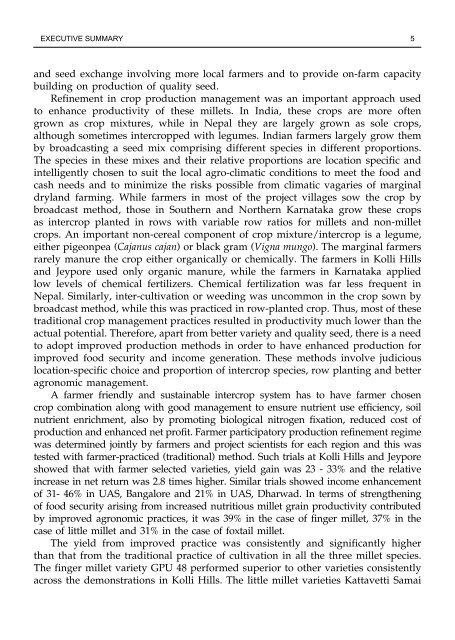Minor millets in South Asia: learnings from IFAD-NUS project in India ...
Minor millets in South Asia: learnings from IFAD-NUS project in India ...
Minor millets in South Asia: learnings from IFAD-NUS project in India ...
Create successful ePaper yourself
Turn your PDF publications into a flip-book with our unique Google optimized e-Paper software.
executive suMMAry 5<br />
and seed exchange <strong>in</strong>volv<strong>in</strong>g more local farmers and to provide on-farm capacity<br />
build<strong>in</strong>g on production of quality seed.<br />
Ref<strong>in</strong>ement <strong>in</strong> crop production management was an important approach used<br />
to enhance productivity of these <strong>millets</strong>. In <strong>India</strong>, these crops are more often<br />
grown as crop mixtures, while <strong>in</strong> Nepal they are largely grown as sole crops,<br />
although sometimes <strong>in</strong>tercropped with legumes. <strong>India</strong>n farmers largely grow them<br />
by broadcast<strong>in</strong>g a seed mix compris<strong>in</strong>g different species <strong>in</strong> different proportions.<br />
The species <strong>in</strong> these mixes and their relative proportions are location specific and<br />
<strong>in</strong>telligently chosen to suit the local agro-climatic conditions to meet the food and<br />
cash needs and to m<strong>in</strong>imize the risks possible <strong>from</strong> climatic vagaries of marg<strong>in</strong>al<br />
dryland farm<strong>in</strong>g. While farmers <strong>in</strong> most of the <strong>project</strong> villages sow the crop by<br />
broadcast method, those <strong>in</strong> <strong>South</strong>ern and Northern Karnataka grow these crops<br />
as <strong>in</strong>tercrop planted <strong>in</strong> rows with variable row ratios for <strong>millets</strong> and non-millet<br />
crops. An important non-cereal component of crop mixture/<strong>in</strong>tercrop is a legume,<br />
either pigeonpea (Cajanus cajan) or black gram (Vigna mungo). The marg<strong>in</strong>al farmers<br />
rarely manure the crop either organically or chemically. The farmers <strong>in</strong> Kolli Hills<br />
and Jeypore used only organic manure, while the farmers <strong>in</strong> Karnataka applied<br />
low levels of chemical fertilizers. Chemical fertilization was far less frequent <strong>in</strong><br />
Nepal. Similarly, <strong>in</strong>ter-cultivation or weed<strong>in</strong>g was uncommon <strong>in</strong> the crop sown by<br />
broadcast method, while this was practiced <strong>in</strong> row-planted crop. Thus, most of these<br />
traditional crop management practices resulted <strong>in</strong> productivity much lower than the<br />
actual potential. Therefore, apart <strong>from</strong> better variety and quality seed, there is a need<br />
to adopt improved production methods <strong>in</strong> order to have enhanced production for<br />
improved food security and <strong>in</strong>come generation. These methods <strong>in</strong>volve judicious<br />
location-specific choice and proportion of <strong>in</strong>tercrop species, row plant<strong>in</strong>g and better<br />
agronomic management.<br />
A farmer friendly and susta<strong>in</strong>able <strong>in</strong>tercrop system has to have farmer chosen<br />
crop comb<strong>in</strong>ation along with good management to ensure nutrient use efficiency, soil<br />
nutrient enrichment, also by promot<strong>in</strong>g biological nitrogen fixation, reduced cost of<br />
production and enhanced net profit. Farmer participatory production ref<strong>in</strong>ement regime<br />
was determ<strong>in</strong>ed jo<strong>in</strong>tly by farmers and <strong>project</strong> scientists for each region and this was<br />
tested with farmer-practiced (traditional) method. Such trials at Kolli Hills and Jeypore<br />
showed that with farmer selected varieties, yield ga<strong>in</strong> was 23 - 33% and the relative<br />
<strong>in</strong>crease <strong>in</strong> net return was 2.8 times higher. Similar trials showed <strong>in</strong>come enhancement<br />
of 31- 46% <strong>in</strong> UAS, Bangalore and 21% <strong>in</strong> UAS, Dharwad. In terms of strengthen<strong>in</strong>g<br />
of food security aris<strong>in</strong>g <strong>from</strong> <strong>in</strong>creased nutritious millet gra<strong>in</strong> productivity contributed<br />
by improved agronomic practices, it was 39% <strong>in</strong> the case of f<strong>in</strong>ger millet, 37% <strong>in</strong> the<br />
case of little millet and 31% <strong>in</strong> the case of foxtail millet.<br />
The yield <strong>from</strong> improved practice was consistently and significantly higher<br />
than that <strong>from</strong> the traditional practice of cultivation <strong>in</strong> all the three millet species.<br />
The f<strong>in</strong>ger millet variety GPU 48 performed superior to other varieties consistently<br />
across the demonstrations <strong>in</strong> Kolli Hills. The little millet varieties Kattavetti Samai

















